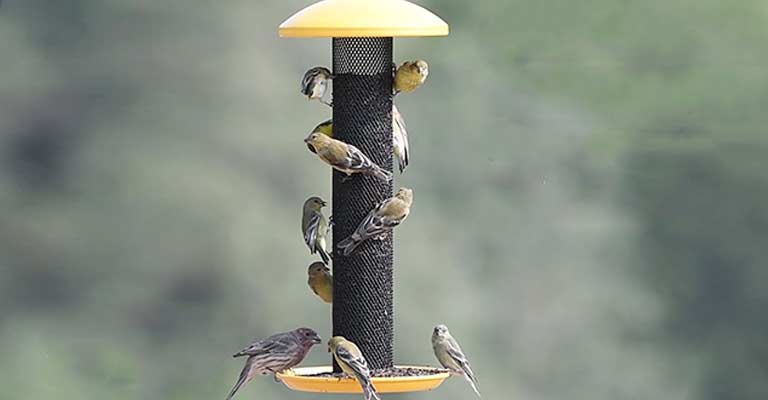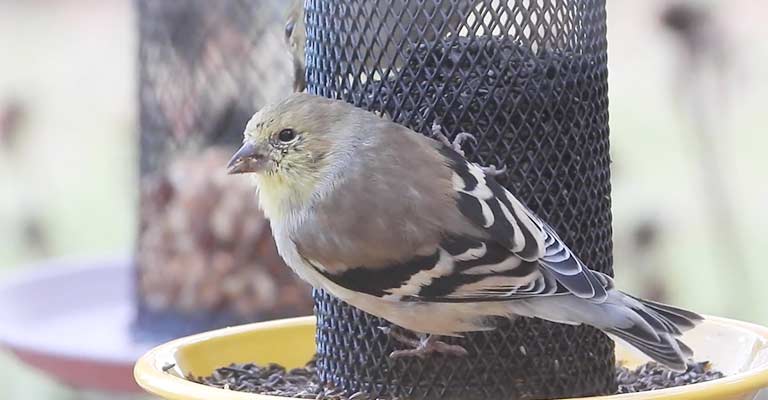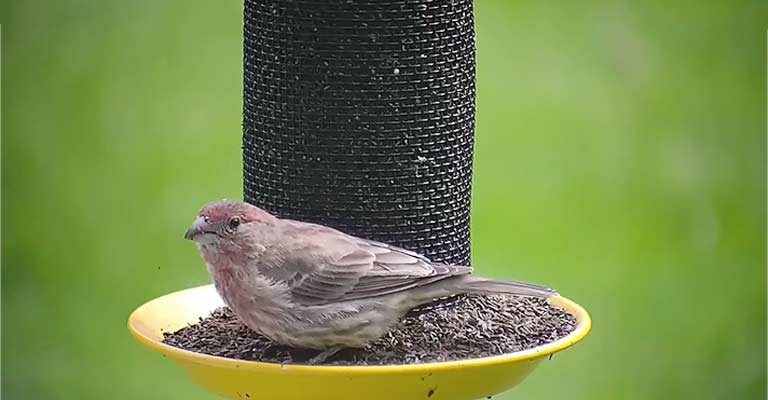The enchanting presence of finches in our surroundings adds a vibrant touch to birdwatching experiences. To cultivate a welcoming habitat for these lively birds, understanding when to put out thistle seed for finches becomes pivotal.
This careful timing aligns with the natural rhythms of their lives, ensuring that these small, colorful creatures find a consistent and nutritious food source.
From the migratory patterns of spring to the energy demands of breeding and the challenges of winter, discerning the opportune moments to offer thistle seeds provides a glimpse into the delicate balance between the avian world and our efforts to support it.

When Should We Put Out Thistle Seed For Finches?
Here’s when to put out thistle seed for finches:
Spring Migration
One optimal time to put out thistle seeds for finches is during spring migration. Many finch species, such as goldfinches, embark on extensive migrations during this season.
Offering thistle seeds in feeders provides a nutrient-rich and energy-dense food source, aiding the finches as they travel long distances.
Breeding Season
During the breeding season, which typically occurs in late spring and early summer, finches have increased nutritional needs. Placing thistle seeds in feeders supports nesting pairs in raising their chicks by providing a high-protein diet essential for the development of young birds.
Fall and Winter Months
Finches, especially those like the American Goldfinch, rely on thistle seeds as a crucial winter food source. Putting out thistle seeds in the fall and winter helps these birds build up fat reserves and provides essential nutrients when natural food sources are scarce.
Harsh Weather Conditions
In regions experiencing harsh weather conditions, such as extreme cold or storms, finches may struggle to find natural food sources. Placing thistle seeds in feeders during adverse weather provides a reliable and easily accessible food supply for finches when foraging becomes challenging.
Molting Periods
Finches undergo molting, where they shed old feathers and grow new ones, typically in late summer or early fall. During this energy-intensive process, providing thistle seeds can support finches by supplying the necessary proteins and fats for feather regrowth.
Post-Breeding Season
After the breeding season concludes, finches may continue to benefit from thistle seeds as they recover from the demands of raising chicks.
Offering thistle seeds during the post-breeding season helps sustain adult finches and prepares them for potential migratory journeys.
Year-Round Availability
While specific seasons are crucial, providing thistle seeds year-round ensures a consistent and reliable food source for finches.
This helps build a loyal finch community in your area, fostering their well-being and creating a reliable spot for birdwatchers to observe these colorful and energetic birds.
In summary, the optimal times to put out thistle seeds for finches include spring migration, the breeding season, fall and winter months, harsh weather conditions, molting periods, post-breeding season, and ensuring year-round availability.
Understanding the varied needs of finches throughout the year ensures a continuous and supportive food source for these charming birds.
When Should You Change Your Finch’s Seeds?

Here’s when should you change your finch’s seeds:
Regular Monthly Rotation
Change your finch seeds regularly on a monthly basis to ensure freshness and quality. Over time, seeds may lose their nutritional value and become less appealing to finches.
Monthly rotation helps maintain a consistent supply of high-quality seeds, supporting the health and well-being of your finches.
Seasonal Changes
Adjusting finch seeds according to seasonal changes is crucial. In colder months, finches may benefit from seeds with higher fat content to provide energy for staying warm.
During breeding seasons, a mix with added protein supports the nutritional needs of nesting pairs and growing chicks.
Seed Spillage or Spoilage
Change finch seeds immediately if you notice spillage or spoilage in the feeder. Wet or moldy seeds can pose health risks to finches and may deter them from feeding.
Regularly clean and inspect feeders to ensure the seeds remain fresh and uncontaminated.
Signs of Pest Infestation
If you observe signs of pest infestation, such as insect activity or the presence of rodents, it’s time to change the finch seeds. Infested seeds can compromise the health of finches and contribute to the spread of pests.
Ensure storage containers are secure and regularly cleaned to prevent infestations.
Decreased Finch Activity
A decrease in finch activity around the feeder may indicate a need for a seed change. Finches are sensitive to seed quality, and a decline in feeding interest could be a sign that the current seeds are no longer appealing. Fresh seeds can rekindle their interest and encourage regular visits.
Transitioning Life Stages
Change finch seeds when the birds are transitioning between life stages. For example, during molting periods or after the breeding season, adjust the seed mix to meet the specific nutritional requirements of finches. Offering a well-balanced diet supports their health during these critical phases.
Seeds Exceeding Expiry Date
Always check the expiration date on seed packaging, and change finch seeds if they have exceeded their shelf life. Expired seeds may lack nutritional value and could potentially harbor contaminants.
Regularly replenishing seeds with fresh batches ensures your finches receive the best possible dietary support.
Changing finch seeds regularly is essential for maintaining the health and vitality of your feathered friends.
Monthly rotations, adapting to seasonal changes, addressing spillage or spoilage, responding to signs of pest infestation, noting decreased finch activity, adjusting for life stage transitions, and adhering to seed expiration dates collectively contribute to providing a nutritionally balanced and appealing diet for finches.
Why Thistle Seed Is Good For Finches?

Here’s why thistle seed is good for finches:
Rich in Healthy Fats
Thistle seeds, often referred to as Nyjer or Niger seeds, are rich in healthy fats, particularly omega-3 fatty acids.
These fats are essential for the overall health of finches, supporting their energy requirements, metabolism, and the maintenance of optimal feather condition.
The abundance of omega-3 fatty acids in thistle seeds contributes to finches’ vitality and helps them thrive.
High Protein Content
Thistle seeds boast a high protein content, a crucial nutritional component for finches, especially during demanding periods like breeding and molting.
Protein is vital for muscle development, tissue repair, and the growth of feathers, making thistle seeds an ideal choice to support the dietary needs of these active and dynamic birds.
Attracts a Variety of Finch Species
Thistle seeds have a universal appeal that attracts a variety of finch species, including the vibrant American Goldfinch and the energetic House Finch.
Their small size and easy accessibility make thistle seeds a preferred food source, promoting diversity in your backyard as different finch species flock to partake in this nutritious offering.
Minimal Germination Risk
Unlike some other seeds, thistle seeds have minimal germination potential. This quality ensures that spilled or discarded seeds are less likely to sprout and create unwanted plants in your garden.
This feature makes thistle seeds an excellent choice for those who wish to avoid the hassle of managing seedlings around their feeders.
Preferred by Finches
Finches exhibit a distinct preference for thistle seeds, often favoring them over other seed types. The small size, texture, and nutritional profile of thistle seeds align with the natural feeding behaviors of finches.
Offering thistle seeds in feeders ensures that you are providing a food source that resonates with the finches’ taste and dietary preferences.
Effective Feeding in Specialized Feeders
Thistle seeds can be efficiently dispensed using specialized finch feeders equipped with small openings. These feeders prevent seed spillage, reduce waste, and offer an effective way for finches to access the seeds.
The design of these feeders encourages finches to cling and feed comfortably, enhancing the overall birdwatching experience.
Year-Round Nutritional Support
Thistle seeds provide year-round nutritional support for finches. Whether during the colder months when other natural food sources are scarce or during the breeding season when increased nutritional demands arise, thistle seeds offer a consistent and reliable supply of essential nutrients, contributing to the overall health and well-being of finches.
Thistle seeds are an exceptional dietary choice for finches due to their rich content of healthy fats, high protein levels, universal appeal to various finch species, minimal germination risk, preference by finches, effective use in specialized feeders, and the provision of year-round nutritional support.
Incorporating thistle seeds into finch feeding routines ensures a well-balanced diet that aligns with the specific nutritional needs and preferences of these charming birds.
How Long Does Thistle Seed Last?

Here’s how long does thistle seed lasts:
Unopened Packets – Up to 2 Years
Unopened packets of thistle seeds, when stored in a cool, dry place away from moisture and pests, can last for up to two years.
The key to preserving the freshness of thistle seeds is to keep them in their original packaging or transfer them to airtight containers to prevent exposure to air and humidity.
Opened Packets – 6 Months to 1 Year
Once a packet of thistle seeds is opened, its freshness is more vulnerable to environmental factors.
When stored in a sealed container in a cool and dry environment, opened packets can maintain their quality for approximately six months to one year. Regularly inspect the seeds for any signs of mold or spoilage during this period.
Stored in Refrigerator – Extended Freshness
For extended freshness, consider storing thistle seeds in the refrigerator. The cool and controlled environment of the refrigerator can help prolong the life of thistle seeds beyond the typical storage duration.
Ensure the seeds are in a sealed container to protect them from moisture and odors.
During Peak Seasons – 3 to 4 Months
Thistle seeds are often in high demand during peak bird-feeding seasons, such as winter and spring. To maintain optimal freshness, aim to use thistle seeds within three to four months during these periods.
Frequent replenishment ensures that birds receive the highest quality seeds for their nutritional needs.
Regular Feeding Schedule – 2 to 3 Months
If you maintain a regular feeding schedule for finches using thistle seeds, aim to replenish the supply every two to three months. Regularly rotating and refreshing the seeds not only ensures their nutritional value but also attracts a diverse array of finches to your feeders.
Environmental Conditions Impact – Check for Spoilage
Environmental conditions play a significant role in the longevity of thistle seeds. In humid climates or areas prone to temperature fluctuations, the seeds may be susceptible to spoilage.
Regularly check for signs of mold, foul odor, or changes in appearance, and discard any compromised seeds to maintain the quality of the remaining supply.
Seeds Exceeding Expiration Date – Discard
Always be attentive to the expiration date on the packaging of thistle seeds. Once the seeds exceed this date, their nutritional value may decline, and the risk of spoilage increases.
To ensure the well-being of finches, promptly discard any thistle seeds that have surpassed their expiration date and replace them with fresh ones.
The longevity of thistle seeds varies depending on factors like storage conditions, whether they are opened or unopened, and the presence of environmental influences.
From unopened packets lasting up to two years to regular feeding schedules requiring replenishment every two to three months, understanding the timeframes ensures that finches receive the freshest and most nutritious thistle seeds.
FAQs
When is the best time to start offering thistle seeds for finches?
The best time to start offering thistle seeds for finches is during spring migration. As finches embark on extensive journeys, the energy-rich thistle seeds provide crucial nutrition.
Is there a specific season for putting out thistle seeds for breeding finches?
Yes, during late spring and early summer, when finches enter their breeding season, it’s beneficial to provide thistle seeds. The high protein content supports nesting pairs in raising their chicks, ensuring a well-balanced diet for optimal reproductive success.
Should thistle seeds be offered in the fall and winter months?
Absolutely. Thistle seeds are particularly important during fall and winter when natural food sources become scarce. These seeds, rich in fats, help finches build up energy reserves for the colder months and provide essential nutrients when other food options are limited.
Are there specific times during the day to put out thistle seeds for finches?
Finches are most active during the morning and late afternoon. Placing thistle seeds in feeders during these times increases the likelihood of attracting finches.
However, keeping feeders consistently filled throughout the day ensures that finches have access to this nutritious food source whenever they visit.
Can thistle seeds be offered year-round, including during molting periods?
Yes, thistle seeds can be offered year-round, providing continuous nutritional support for finches. During molting periods, the protein-rich content of thistle seeds aids in feather regrowth.
Conclusion
In the delicate choreography of nature, the timing of putting out thistle seeds for finches emerges as a nuanced art.
Whether catering to their nutritional needs during migration, breeding, or the lean winter months, each season unfolds unique opportunities. The careful observer, attuned to the rhythms of finch life, ensures a continuous banquet of thistle seeds.
As we synchronize our offerings with the changing seasons, we not only attract these delightful birds but contribute to their well-being, fostering a harmonious connection between the feathered residents and the enthusiasts who delight in their fleeting visits.